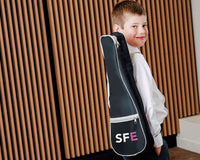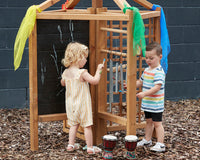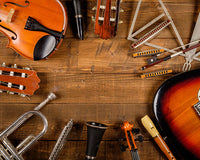So, first things first…

While the clarinet and oboe are both instruments of the woodwind family and do look very similar, there are quite a few differences between them...
1 ) The Appearance
If you were to look from afar, these would look almost identical. However, there are a few small differences that will help you tell them apart.
| CLARINET |
OBOE |
| Includes: Bell, Lower Joint, Upper Joint, Barrel and Mouthpiece |
Includes: Bell, Lower Joint, Upper Joint, Staple and a Reed |
| Single Reed |
Double Reed |
| Cylindrical Bore |
Conical Bore |
| Flared Bell |
Rounded Bell |
| Mostly Open Tone Holes |
Mostly Closed Tone Holes |
| Length: 27.5 Inches |
Length: 26 Inches |
2 ) The Reed

This is arguably one of the biggest differences. Most people will know and recognise that the clarinet has a single reed that sits on the mouthpiece and is held by a ligature. On the other hand, the oboe is a double reed instrument which means it uses two reeds sat next to each other to produce a sound. This contributes to the different tones created by these two instruments and the technique/embouchure needed to play them.
3 ) The Tone
Another difference is the tone it produces. The different tones is caused by many things, including the reeds and bore. The clarinet produces a mellow, rounded tone, especially in the lower ranges. On the other hand, the tone that an oboe produces is much brighter and clear which is derived from its conical bore. The oboe is mainly used in classical music, whereas the clarinet is used in more genres such as jazz, due to its larger range and softer tone. Despite these differences, they aren’t worlds apart. The clarinet and oboe are both woodwind instruments which means they both require similar embouchure's and similar breathing techniques.
 Fun fact: If you have ever been to watch an orchestra and you hear everyone tuning to the first oboe, this is because the oboe is in the key of C (concert pitch) and is easily heard over all the other instruments due to its unique tone.
Fun fact: If you have ever been to watch an orchestra and you hear everyone tuning to the first oboe, this is because the oboe is in the key of C (concert pitch) and is easily heard over all the other instruments due to its unique tone.
Clarinets
So, you're looking to play the clarinet but not sure what model to go for? This Montreux clarinet is very popular with educational services and beginners of any age. It is an excellent sounding clarinet through the range and is great value for money. Constructed with an ABS body, the instrument is light, robust and and has a responsive tone. The power forged nickel silver keys and adjustable thumb rest makes this clarinet even easier to play. Things included with the clarinet;
- Clarinet
- Mouthpiece
- Ligature
- Mouthpiece cap
- Cork grease
- Carry case
- Detachable straps
There is also a
pack available which includes many more accessories, such as a clarinet stand, a care kit and a box of reeds.
Oboes
In contrast to the clarinet, the oboe is much more expensive. But don’t get me wrong, it is a great instrument and definitely worth the price if you are looking to take this into a professional career playing the oboe. However, if you are just starting out, you should be pointing in the direction of our Montreux Oboes. They are at a much lower price, whilst not lacking in quality.
This Junior Oboe by Sonata is ideal for beginners and is perfect for smaller hands. If you have never played the oboe before, you may want to start on this. It has simplified key work and is therefore much easier to learn.
The Student Oboe is an oboe with all the standard keys. If you are beginner and don't want to splash the cash on an expensive instrument, like all sonata products, this would be perfect. Despite the low cost, it does not lack in quality. It's made with a ABS resin body, meaning its robust and lightweight. It has 28, nickel silver plated keys and a thumb plate mechanism, which is a requirement for any oboe player.
 While the clarinet and oboe are both instruments of the woodwind family and do look very similar, there are quite a few differences between them...
While the clarinet and oboe are both instruments of the woodwind family and do look very similar, there are quite a few differences between them...
 This is arguably one of the biggest differences. Most people will know and recognise that the clarinet has a single reed that sits on the mouthpiece and is held by a ligature. On the other hand, the oboe is a double reed instrument which means it uses two reeds sat next to each other to produce a sound. This contributes to the different tones created by these two instruments and the technique/embouchure needed to play them.
This is arguably one of the biggest differences. Most people will know and recognise that the clarinet has a single reed that sits on the mouthpiece and is held by a ligature. On the other hand, the oboe is a double reed instrument which means it uses two reeds sat next to each other to produce a sound. This contributes to the different tones created by these two instruments and the technique/embouchure needed to play them.
 Fun fact: If you have ever been to watch an orchestra and you hear everyone tuning to the first oboe, this is because the oboe is in the key of C (concert pitch) and is easily heard over all the other instruments due to its unique tone.
Fun fact: If you have ever been to watch an orchestra and you hear everyone tuning to the first oboe, this is because the oboe is in the key of C (concert pitch) and is easily heard over all the other instruments due to its unique tone.




















